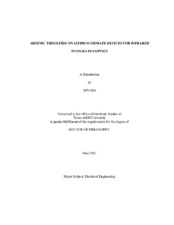| dc.contributor.advisor | Madsen, Christi K. | |
| dc.creator | Xia, Xin | |
| dc.date.accessioned | 2012-07-16T15:57:05Z | |
| dc.date.accessioned | 2012-07-16T20:16:54Z | |
| dc.date.available | 2012-07-16T15:57:05Z | |
| dc.date.available | 2012-07-16T20:16:54Z | |
| dc.date.created | 2011-05 | |
| dc.date.issued | 2012-07-16 | |
| dc.date.submitted | May 2011 | |
| dc.identifier.uri | https://hdl.handle.net/1969.1/ETD-TAMU-2011-05-9362 | |
| dc.description.abstract | Arsenic trisulfide (As₂S₃) waveguide devices on lithium niobate substrates (LiNbO₃) provide a set of compact and versatile means for guiding and manipulating optical modes in infrared integrated optical circuits, including the integrated trace gas detection system. As a member of the chalcogenide glass family, As₂S₃ has many properties superior to other materials, such as high transparency up to 10 [mu]m, large refractive index and high nonlinear coefficient. At the wavelength of 4.8[mu]m, low-loss As₂S₃ waveguides are achieved: The propagation loss is 0.33 dB/cm; the coupling efficiency is estimated to be 81 %; and less than 3 dB loss is measured for a 90-degree bent waveguide of 250 [mu]m bending radius. They offer an ideal solution to the optical interconnection -- the fundamental element of an optical circuit. LiNbO₃ is a birefringent crystal that has long been studied as the substrate material. Titanium diffused waveguides in lithium niobate substrate (Ti: LiNbO₃) have excellent electro-optical properties, based on which, on-chip polarization converters are demonstrated. New benefits can be obtained by integrating As₂S₃ and Ti: LiNbO₃ to form a hybrid waveguide, which benefits from the high index contrast of As₂S₃ and the electro-optical properties of Ti: LiNbO₃ as well as its easy connection with commercial single mode fibers. For hybrid waveguides, the mode coupling is key. A taper coupler is preferred owing to its simplicity in design and fabrication. Although preliminary experiments have shown the feasibility of such integration, the underlying mechanism is not well understood and guidelines for design are lacking. Therefore, a simulation method is first developed and then applied to the taper coupler design. Devices based on taper couplers are then fabricated and characterized. The study reveals that in the presence of mode beating, it is not necessarily the longer taper that is the better coupling. There exists an optimum length for a taper with fixed width variation. A two-stage taper design can largely reduce the total length, e. g. by 64%, while keeping the coupling efficiency above 90%. According to the frequency domain analysis, these practical taper couplers work for a wavelength range instead of a single wavelength. | en |
| dc.format.mimetype | application/pdf | |
| dc.language.iso | en_US | |
| dc.subject | Integrated optical circuits | en |
| dc.subject | chalcogenide glass waveguides | en |
| dc.subject | integrated polarization converters | en |
| dc.subject | mode couplers | en |
| dc.title | Arsenic Trisulfide on Lithium Niobate Devices for Infrared Integrated Optics | en |
| dc.type | Thesis | en |
| thesis.degree.department | Electrical and Computer Engineering | en |
| thesis.degree.discipline | Electrical Engineering | en |
| thesis.degree.grantor | Texas A&M University | en |
| thesis.degree.name | Doctor of Philosophy | en |
| thesis.degree.level | Doctoral | en |
| dc.contributor.committeeMember | Eknoyan, Ohannes | |
| dc.contributor.committeeMember | Chan, Andrew K. | |
| dc.contributor.committeeMember | Weimer, Michael B. | |
| dc.type.genre | thesis | en |
| dc.type.material | text | en |


